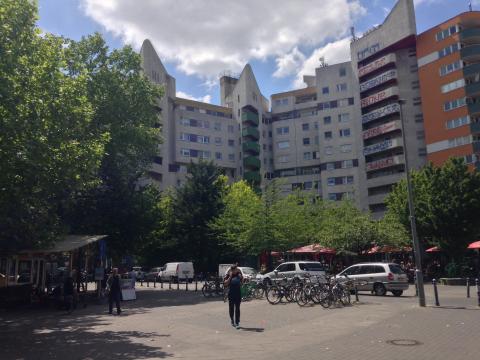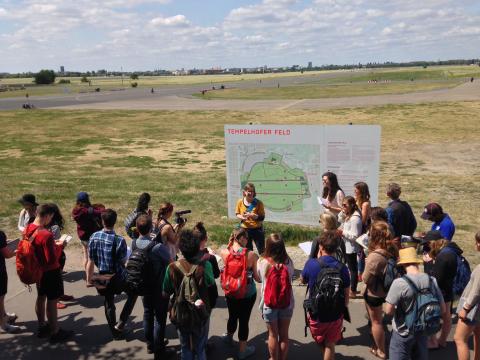We took a tour of a couple of Berlin’s more alternative neighbourhoods, Neukölln
(formerly Rixdorf) and Kreuzberg. We met with planners Aljoscha Hofmann and
Cordelia Polinna. Both areas had fascinating histories, and currently face
monumental development pressures.
Rixdorf, one of the villages that was united to form greater Berlin, was devastated by the 30 years war in the 1600s. After hundreds of years of rebuilding the urban structure of Rixdorf was changed to accommodate the growing population of the mid-late 19th century. Out of this restructuring of urban form came the tenant block, with very diverse mixed use buildings and courtyards. Signs of mixed-use planning were prevalent as local businesses were at the bottom floor of each building. Over time Rixdorf became a working class neighborhood that was overcome with poverty. In an effort to change the atmosphere and reputation of the neighborhood, the city changed the name of Rixdorf to Neukölln. The conditions did not get much better, and the neighborhood hit a very low point of drugs, violence, illness, and poor education from the 1990s to 2005, when the state decided to intervene in the neighborhood. Although some of the city-led initiatives have met with little success, the neighbourhood has for the most part become a more desirable place to live. Accordingly, Neukölln has become a highly contest space since then as the process of gentrification is aggressively creeping in.
Protest culture and immigration both play crucial roles in Kreuzberg. One fascinating place that they intersect is within the social housing issue. Berliners, and people from Kreuzberg specifically, have been expressing their frustration with rising rents and inadequate social housing both for Germans and refugees through a series of protests and by spreading information. The base of this initiative is the small wooden hut that was built at Kottbusser Tor a couple of years ago (see photo below). It was built overnight, in accordance with the Turkish tradition whereby any building that was built in the night and completed by dawn could not be torn down by the authorities. It is now a place where volunteers meet and coordinate their efforts, including a petition to the Senate to reverse the privatization of social housing. A few of the traditionally social housing buildings, one of which is pictured below,
were sold to private developers. This one was sold under the condition that it would
remain low income public housing for ten years. However, the ten year period is
now up, and the people who live there are not willing to leave, particularly when
other options have not been provided. The residents of the area collected
signatures to force the Senate to buy back the social housing, which, while an
excellent example of bottom up legislation, is not particularly welcomed by the
senate. One particularly interesting thing to note is the very strong involvement of working class Turkish women in the protest movement, which is a unique aspect of the protests here resulting from the strong immigrant community.


We visited some really unique public places in Berlin. One of the fascinating
spaces we had the opportunity to see, Tempelhofer Feld, is a converted airport,
which is used today as a multi-purposed public space. We viewed the park on a hot afternoon and the atmosphere of the park was very lively; people were running,
walking, biking, rollerblading, having picnics, and gardening. Another space we
visited was Oranienplatz, a public space that is quite peaceful during the day but has
also been a designated space for protesting. The interesting thing about
Oranienplatz is that it was initially being built up as a massive highway until the
citizens of Berlin rallied against the highway. Both of these sites represent
transformed urban spaces that were converted from their original use of primarily
unsustainable transportation into socially sustainable public place. Both projects also
had heavy public involvement, although the highway had them lobbying strongly
against its proposed existence, while the airport had an equally vocal desire for its
preservation and repurposing. The success of these public spaces demonstrates the
power of a ‘bottom-up’ grassroots approach to accomplish sustainable public life
and place.

